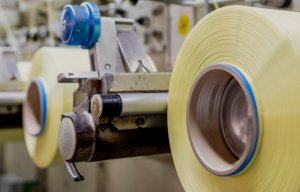
Circular success with Twaron
Teijin Aramid is launching a new anti-ballistic spall-liner solution at the DSEI show in London next week. The new fabric, Twaron T765, offers cost-effective ballistic protection in ground vehicles. Designed for protecting military vehicles against bullets, fragments, Improvised Explosive Devices (IEDs), mine blasts and projectiles according to STANAG 4569, levels 1-4, it can also be used as a protection in civilian vehicles against lower-level threats, the company reports.

3rd September 2013
Innovation in Textiles
|
Arnhem
Teijin Aramid is launching a new anti-ballistic spall-liner solution at the DSEI show in London next week. The new fabric, Twaron T765, offers cost-effective ballistic protection in ground vehicles.
Designed for protecting military vehicles against bullets, fragments, Improvised Explosive Devices (IEDs), mine blasts and projectiles according to STANAG 4569, levels 1-4, it can also be used as a protection in civilian vehicles against lower-level threats, the company reports.
Spall liners made of Twaron T765 can be used for protecting vehicles such as tanks, trucks and armoured personnel carriers and its passengers.
Spall liners provide extra support for the outer faces of armoured vehicles. In the event of an impact or explosion on the surface, they help to prevent or reduce fragmentation of the vehicle structure. This is important, as fragments flying around the interior can often cause more injury to passengers than the explosion itself.
According to Teijin Aramid, Twaron T765 is ideal for use in composite armour solutions designed for the armouring of vehicles especially in combination with steel, ceramic, aluminium and titanium.
Usually, fabrics used for spall liners are woven structures. Twaron 765, however, uses warp-knitting technology. This state-of-the-art-process, which is also used to create advanced 3D glass-fibre constructions, is said to result in a fabric that’s heavier and sturdier.
This means that less layers are needed to meet the high ballistic specifications. In addition, less material has to be purchased, processed and treated during production. The company believes, this can lead to substantial savings and enable more economical ballistic solutions, while delivering a high level of ballistic protection.

Business intelligence for the fibre, textiles and apparel industries: technologies, innovations, markets, investments, trade policy, sourcing, strategy...
Find out more